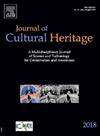Preliminary evaluation of green terpolymer of nano poly (methyl methacrylate/dimethylaminoethyl methacrylate/acrylamide) for the consolidation of bone artifacts
IF 3.5
2区 综合性期刊
0 ARCHAEOLOGY
引用次数: 0
Abstract
Weakness and fragility are the main aspects of damage to archaeological bones in excavation areas, museums and storage facilities caused by improper conditions. The objective of the study is to assess the efficacy of nano-terpolymers composed of methyl methacrylate, dimethylaminoethyl methacrylate, and acrylamide, which have been synthesized under environmentally friendly conditions, for the consolidation of bone artifacts. To achieve this study, samples of modern sheep animal bones were prepared and subjected to thermal aging. Subsequently, these samples were treated with the prepared terpolymer at different concentrations. The treated samples were then thermally aged to test the efficiency of the material. The characteristics of the prepared terpolymer were measured using transmission electron microscopy (TEM), Fourier transform infrared spectroscopy (FTIR), and thermo gravimetric analysis (TAG). The bone samples treated with different concentrations of the prepared terpolymer were analyzed before and after heat aging using modeling, different microscopes and measurement of color change. The findings from the majority of investigation conducted in this study suggest that the ideal concentration of the polymer for the treatment of fragile and weak bones is 4 % followed by 2 % being the next most effective concentration. The 6 % concentration should be disregarded, as it produced unfavorable outcomes from a conservation perspective. Moreover, the density functional theory (DFT) investigation of the synthesized terpolymer with bone structure showed the electrostatic intramolecular hydrogen bond interaction with amino acids of collagen and calcium hydroxyapatite which gave it stability.

纳米聚(甲基丙烯酸甲酯/甲基丙烯酸二甲氨基乙酯/丙烯酰胺)绿色三元聚合物对人工骨加固的初步评价
软弱和易损是发掘区、博物馆和储存设施中由于条件不当造成的考古骨骼损坏的主要方面。本研究的目的是评估在环境友好条件下合成的由甲基丙烯酸甲酯、甲基丙烯酸二甲氨基乙酯和丙烯酰胺组成的纳米三元聚合物对人工骨固化的效果。为了实现这项研究,制备了现代绵羊动物骨骼样本并进行了热老化。随后,用制备的三元共聚物在不同浓度下对这些样品进行处理。然后对处理过的样品进行热老化,以测试材料的效率。采用透射电子显微镜(TEM)、傅里叶变换红外光谱(FTIR)和热重分析(TAG)对所制备的三元共聚物进行了表征。用不同浓度的三元共聚物处理骨样品,通过建模、不同显微镜和测量颜色变化来分析热老化前后的骨样品。在这项研究中进行的大多数调查结果表明,治疗脆弱和脆弱骨骼的聚合物的理想浓度是4%,其次是2%。6%的浓度应该忽略,因为从保护的角度来看,它产生了不利的结果。此外,对所合成的具有骨结构的三元共聚物进行了密度泛函理论(DFT)研究,发现其与胶原蛋白氨基酸和羟基磷灰石钙分子内的静电氢键相互作用使其具有稳定性。
本文章由计算机程序翻译,如有差异,请以英文原文为准。
求助全文
约1分钟内获得全文
求助全文
来源期刊

Journal of Cultural Heritage
综合性期刊-材料科学:综合
CiteScore
6.80
自引率
9.70%
发文量
166
审稿时长
52 days
期刊介绍:
The Journal of Cultural Heritage publishes original papers which comprise previously unpublished data and present innovative methods concerning all aspects of science and technology of cultural heritage as well as interpretation and theoretical issues related to preservation.
 求助内容:
求助内容: 应助结果提醒方式:
应助结果提醒方式:


